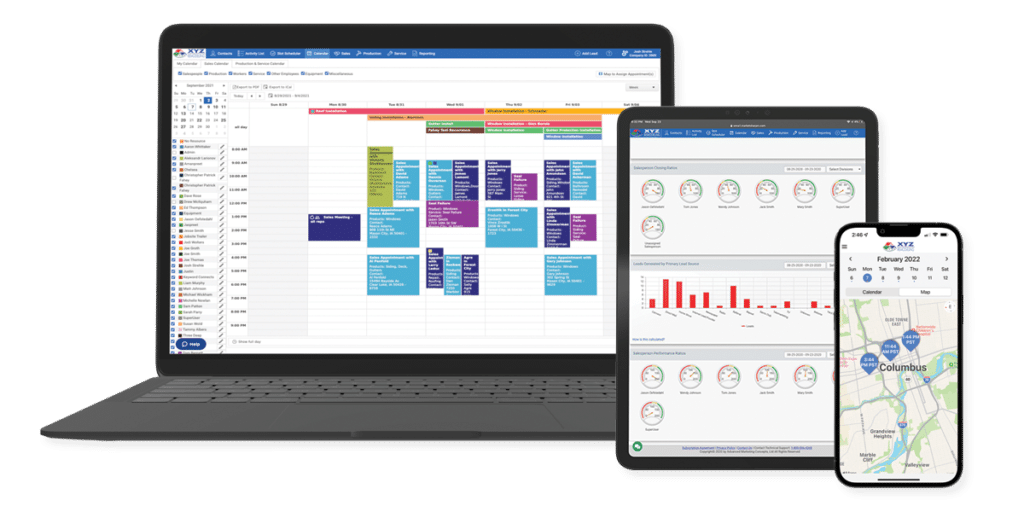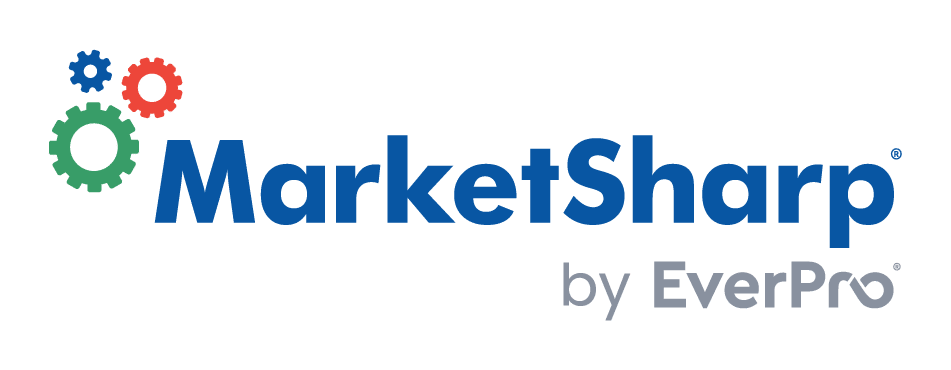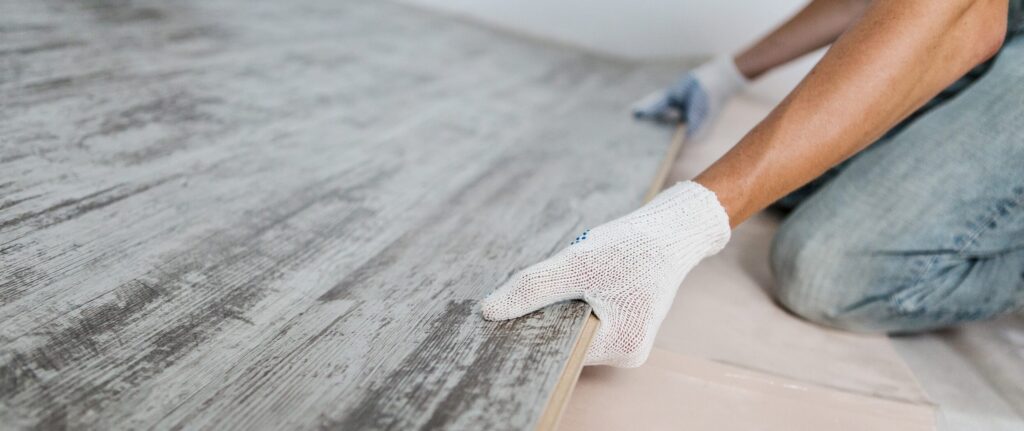
Nearly one in four homeowners plan to start a home improvement project in the next 12 months. And flooring is among the top four most popular home improvements. A market like this means abundant opportunities for flooring installers—if you know how to find the customers. In addition to using management tools to generate more leads, here are 6 ways you can reach more customers, even if you’re brand new to lead generation.
1. Launch New Partnerships
Establishing partnerships with other professionals is a time-tested way of reaching new customers. The key is to partner with complementary businesses that already work with your ideal customers.
A healthy partnership is a two-way street. Ideally, both businesses refer leads to each other.
While you can partner with many kinds of businesses, here are five that complement the flooring business well.
Interior Designers
When interior designers lead their customers through the design process, they partner with contractors who can transform their plans into beautiful spaces–including flooring installers.
Designers highly value contractors who are reliable and do quality work because they help the designer deliver on their vision, on budget, and on time.
Establish good working relationships with designers and design firms, then ask for leads. Be sure to direct leads their way too!
Plumbers
Plumbers work on everything. New construction. Renovations. Water damage. The type of projects that usually include flooring.
Get to know local plumbers and what types of projects they work on. Residential? Commercial? Seek partnerships with those plumbers who serve the kind of customers you desire.
Real Estate Agents / Companies
Real estate agents know that flooring can either entice or turn off potential buyers. When a flooring upgrade can help a home sell quicker and for more money, agents will directly suggest that sellers invest in new flooring.
Real estate agents are also trusted advisers to home buyers. They help buyers see how homes can be transformed from dud to darling with a change of flooring.
Plus, real estate agents frequently work with landlords who need to keep rental properties in good shape.
As participants in many real estate transactions, agents can be a steady source of leads for flooring contractors.
Homeowners Associations (HOAs)
Did you know that 40 million housing units in the U.S. are part of HOA communities? One way to access this sizable residential market is not through the owners but through the homeowner associations.
While HOAs may be averse to promoting your services outright, work you do for the association common areas will make your company visible to the homeowners.
When you work with HOAs you will have to get in front of board members—the decision makers for the association. The members of the board are elected homeowners from the community. They don’t necessarily have expertise about the issues facing the association, like worn out carpet in the clubhouse. If you make yourself available as a consultant whose expertise can be trusted, you’re well positioned to convert the HOA into a customer and a source of leads.
Keep in mind that HOA boards often outsource duties to a property management firm. Don’t let this hinder you, though. It’s worthwhile to develop relationships with property managers because they generally serve multiple clients, any of whom could be your next customer.
Also, when you do a good job for the HOA, board and committee members are likely to recommend your service with homeowners who talk to them about their home renovation plans.
Property Management Firms
Property management firms often have a high volume of properties to keep up with and need to work with reliable partners to update and turn around rentals between tenants. That’s where you and your flooring business can come in!
Property managers are looking for durable flooring that is easy and quick to replace. Building a partnership with a property management firm gives you the chance to be the firm’s go-to flooring expert and to build a solid pipeline of jobs.
How to Reach Out to Potential Partners
Now that you know why cultivating partnerships is so valuable, we made some example email pitches you can fill out and customize to send to potential partners:
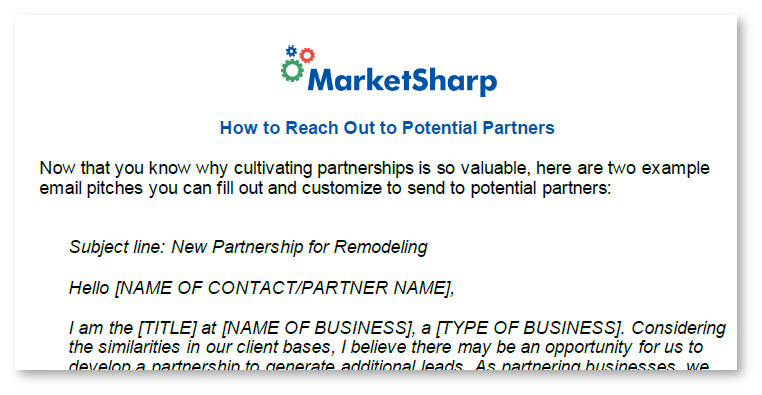

2. Expand Your Network
Your network can never be too big! Who you know has a major influence on the success of your flooring business—and how much of a positive impact you can make in your community. As part of your lead generation strategy, consider getting involved in the following groups and events.
Local Business Associations / Chambers of Commerce
Have you ever met the person who seems to know everyone? Well-connected businesspeople are generally those who actively participate in their local chamber of commerce.
A chamber of commerce is group of businesses designed to support the interests of its members. These groups have existed for over 400 years and for good reason. When members join and actively participate they help one another grow their businesses.
Use the Chamber of Commerce finder to locate the chamber closest to you. Then start building relationships and sharing leads.
Apartment/Rental/Landlord Associations
You may already know that rental grade carpeting has a useful life of five years. But did you know there are 21.3 million apartment homes in the US? And another 266,000 apartments need to be built each year to keep up with housing demands. Between existing and newly constructed units, there are millions of square feet that need flooring.
So, how do you access the rental market? Through associations for apartment owners and landlords. For example, the American Apartment Owners Association provides a list of vendors by ZIP code.
Google “local landlord association” or visit the ApartmentAssociations.com, Landlord.com, and National Apartment Association to find groups near you.
Attending association events can help you open the door to the rental market and generate new leads.
Industry-Specific Trade Shows
Hosting a booth at an industry trade show can help your flooring business develop a presence in your market.
Across the nation, home shows—often hosted by the local builders association— are a great way to get in front of thousands of homeowners within a few days. Regionally, you may also have shows dedicated to cottage, cabin, and lakefront living; all places where folks need flooring.
Even if you don’t exhibit at a trade show, these events are worthwhile as an attendee. As you go booth to booth, you can identify which exhibitors would make good partners for sharing leads, including interior designers, general contractors, and more. Introduce yourself to as many people as possible and collect leads’ names and contact information so you can follow up later.
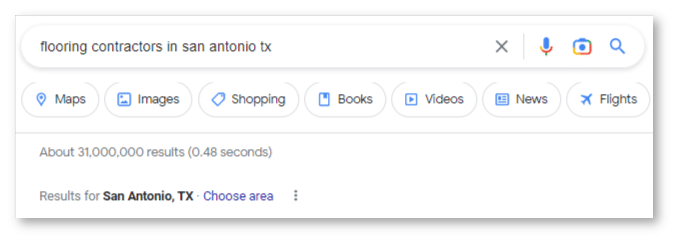
3. Grow With Digital Marketing
If you don’t have an online presence, how will your customers find you? Whether you take a DIY approach or hire a digital marketing expert, here are the basics you need to know to grow with digital marketing.
SEO (Search Engine Optimization)
The foundation of your digital marketing plan is search engine optimization, usually called SEO. Search engines like Google use algorithms to identify keywords to determine what websites and blogs are about. To be successful at digital marketing, you want to create online content that matches what people search for.
Keyword/Local Optimization
Intuitively, you know some keywords your customers will use when searching online. For example, “flooring” is a common search and generates a mix of results, including retailers and installers. You can get more specific by using terms like “flooring installer” and your city name.
Using keywords on your website will help your potential customer find you. Including your location will help ensure your company shows up when folks search for “flooring installer near me.”
Anything you specialize in can become a keyword—like flood damage, brand names you sell, flooring types (hardwood, ceramic tile, vinyl, etc.), and refinishing.
There’s a lot of competition to gain visibility in search results. By using what are called long-tail keywords, you can focus on more specific searches that potential customers will use. For example, “flooring installation for historic homes” will help you connect with a very specific type of homeowner. Add “in Boston” and you’re targeting an even more specific, local audience.
Long-tail keywords won’t attract as much traffic as standard keywords, but the traffic you get will be more aligned with the services you offer.
Organic Search Profiles
Organic search results are the listings that come up after a search based on the content the search engine (like Google) sees on the internet. Organic traffic is a free way that leads can find your business.
Be sure you set up a free business profile on Google. One of the best things about Google business profiles is that they help people find or discover your business.
The Google geolocation feature is especially helpful when a potential customer searches for “flooring installation near me.” With the keywords “flooring installation” in your profile and on your website, as your location on the map, organic search results make you more visible.
Google isn’t the only place to list your business for free.
While Yelp started out as an app for finding restaurants, it’s grown to include many other service providers. Build a free Yelp page so your business shows up for Yelp users.
Another place for gaining organic search traffic is with a free Bing Places for Business listing.
When building organic traffic to generate leads, remember the power of reviews. One of the most useful features for consumers is the reviews that appear on Google, Yelp, and Bing. Be sure to ask current customers to leave an online review—reviews will help with organic search as well as build credibility with leads.
PR & Link-Building
Public relations (PR) and link-building are two strategies for getting other people to talk about your business.
If you’re new to PR, the Public Relations Society of America defines it this way:
“Public relations is a strategic communication process that builds mutually beneficial relationships between organizations and their publics.”
Lots of things are classified as PR. You appear in a newscast following flooding as an expert in dealing with flood damage—that’s PR. Your company sponsors a hole at a charity golf tournament—that’s PR. Your company creates buzz for establishing a trade school scholarship—also PR. These are just a few of the endless PR tactics that help get your name out into the community.
Building backlinks takes place entirely online. This happens when another organization links to your website. Backlinks are valuable because search engines use them ranking search results.
A natural place to start building backlinks is by working with your business partners, like real estate agents and interior designers. Ask them to provide a link to your website from their webpage, blog, or social media posts. And, be sure to return the favor by backlinking to your business partners.
PPC (Pay-Per-Click) Search Advertising
Now that you know more about organic search results, it’s time to talk about paid search results, known in digital marketing as pay-per-click (PPC) search advertising. One of the advantages of PPC is that it helps you get leads faster compared to organic search marketing.
Paid search results are those listings that appear at the top of the search results as ads. In fact, on Google you’ll see “Ad” followed by the advertiser’s website URL in the first line of the listing.
With PPC search ad campaigns, you pay to appear on page 1 of the search results, like this:

Every time someone clicks on this ad, the advertiser pays Google a fee.
Before the ad goes live, the advertiser creates an ad with keywords, chooses their audience, and sets a maximum they’re willing to pay for per click. When and how frequently your ad shows up depends on Google’s algorithm. Google provides step-by-step instructions on creating a PPC search campaign.
BTW: Are you wondering why we keep using Google as our search engine example? Quite simply, it dominates search volume with 91.9% of the market share. PPC ads are also available on other platforms like Meta Ads (formerly known as Facebook Ads), YouTube Ads, and Pinterest.
How much will PPC cost? It depends on several factors but WebFX reports that the average PPC is $2.59 per click and $3.12 per 1000 impressions.
With any campaign, start with a goal. Specifically, what do you want the viewer of the ad to do? No matter which platform you use, the call to action will typically be to visit your website, take advantage of a promotion, or contact you.
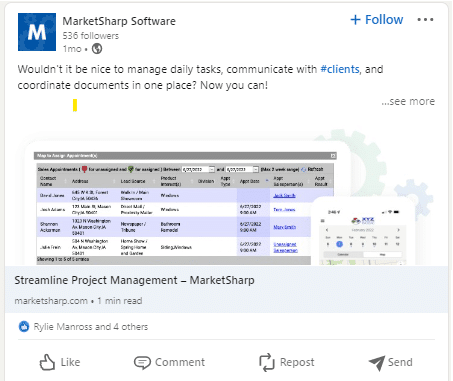
Paid & Organic Social Media
Two hours and 11 minutes—that how long the 76% of Americans who use social media spend scrolling their feeds each day on average. They’re seeing the posts of friends and family, news outlets and influencers, and advertisers. We’re not saying you have to do anything, but if you bypass social media, you’re missing abundant opportunities to generate leads and connect with customers.
Like SEO, there are two ways you can get your flooring installation company in front of eyes on social media: paid and organic. Creating and posting ads is fairly simple because each social media platform offers step-by-step instructions. Here’s a brief overview of four social media platforms where you can connect with prospects and generate leads.
NextDoor
Nextdoor is an app that brings neighbors together to greet newcomers, get local updates, and exchange recommendations. One of the advantages of Nextdoor is that it allows you to target local areas.
Generate organic leads on Nextdoor
The first step in generating organic traffic is to claim your free Nextdoor business page. Then use Nextdoor to collect recommendations to drive word-of-mouth referrals, as well as to post updates, expert advice, and promotions.
Generate paid leads through ads on NextDoor
Ads on Nextdoor appear in three areas: the newsfeed, for sale listings, and on the right had “rail” of the screen. Nextdoor also allows you to use ads to establish a direct line of communication for messaging leads. Get more info on Nextdoor ads.
Love it or hate it, Facebook is a social media powerhouse that counts 71.43% of the U.S. population as users. Plus, two out of three Facebook users visit a local business’s page at least once a week. With reach like this, it’s not surprising that 93% of marketers use Facebook to promote their businesses.
Generate organic leads on Facebook
The way to start connecting with folks on Facebook is with a free business page. Once your page is set up, you can publish content, including photos. Get started with Facebook here.
Generate paid leads through ads on Facebook
With Facebook, you choose your objective, select your audience, and decide where to run your ad. Get more info on Facebook ads.
LinkedIn’s claim to fame is that it’s the world’s largest professional network on the internet. This means it’s the perfect medium for B2B marketing that reaches decision makers, as well as professionals who may need residential flooring. professional network on the internet. This means it’s the perfect medium for B2B marketing that reaches decisions makers, as well as professionals who may need residential flooring.
Generate organic leads on LinkedIn
To join the conversation with other professionals, create your free LinkedIn business page. Provide as much info as possible because pages with complete information get 30% more weekly views. more weekly views.
Generate paid leads through ads on LinkedIn
LinkedIn offers four options for paid marketing: native ads that appear in the LinkedIn feed, sponsored messaging, dynamic ads personalized to your audience, and PPC text ads. Get more info on LinkedIn ads.
Instagram is one of the most popular ways to share photos and videos. By the way, Instagram is owned by Facebook’s parent company, Meta. Having the same parent means cross-promoting content between Facebook and Instagram is streamlined.
Generate organic leads on Instagram
To master Instagram, take time to learn about hashtags that will get your posts seen by more people. Start here to set up an Instagram business account.
Generate paid leads through ads on Instagram
Instagram users welcome ads. In fact, 70% of people surveyed like or don’t mind ads when watching videos on Instagram. Get more info on Instagram ads.
As a flooring contractor, your work can provide very dramatic “Before and After” pictures that are perfect for sharing on social media through paid and organics posts. (Note: Before posting pictures of customer spaces online, be sure to ask your customer for permission.)
Keep in mind, you don’t have to be on all social media platforms. Most businesses concentrate on at least two. In addition to the four listed above, you might also consider Pinterest, Twitter, Tumblr, and TikTok for sharing your content.

4. Move From Mass Mailers to Targeted Mailings
While mass mailings have the potential to get your business name in front of many prospective customers, they’re not very efficient. Targeted mailings will be more effective at generating leads for your flooring business. Here are two ways be more selective about who receives your message.
Homes Sold on MLS That Require Remodel
Homes listed for sale “as-is” indicate fixer-uppers that most likely need new flooring. There are three ways you can target mailings to the owners of these homes:
- If you partner with a real estate agent, ask them to notify you of recently sold homes that need remodeling.
- Regularly scan MLS listings for homes in need of repairs and upgrades. Send a mailer directly to the address.
- Websites like Realtor.com and Zillow offer the ability to search for homes that have recently sold. Review local listings to identify homes that are likely candidates and direct a mailing to the new owner.
Piggyback off of Partner Emails
Partners with businesses that complement yours (interior designers, plumbers, etc.) may already have a well-established email list. Ask if it’s possible to piggyback on their emails, either as a featured business or with a small ad for your flooring business. Be sure to offer something of value in return for their marketing help.

5. Improve Your Remodeling Sales & Customer Experience
It doesn’t matter how many leads you gather if you don’t have a system in place for follow ups. Here are tips on streamlining the process of converting leads into customers, automating emails, and managing your reputation so you get referrals.
Project Management/Productivity Refinement
One of the foundations of building a thriving flooring installation business is professionalism. This means that in addition to doing a job well, you provide clear communication, treat others with respect, and adhere to timelines. Investing in remodeling project management software will help you keep track of leads, stay on top of current work, and follow-up with customers.
Plus, using project management software helps as you add employees because the technology can be used to:
- standardize customer experience
- schedule and map sales appointments
- schedule and track production crews
Automation
Would you order a meal in a restaurant and leave before the server brings the food to your table? Of course not! You’d never leave a meal behind, yet sometimes leads are left on the table because there’s no follow up. The most powerful tools in managing lead follow ups—as well as outreach to existing customers—are automated reminders and emails.
Make automated messaging part of your strategy for converting leads into sales.
Reputation Management
A flooring contractor’s job isn’t done when the installation is complete. You must also grow your reputation and business with online reviews. Reputation management software will help you gather and analyze customer feedback so you can see your company through your customers’ eyes.
When your customers provide positive online reviews, be sure to acknowledge and thank them.
If someone posts a negative review, responding with professionalism will show others that you’re willing to resolve issues that come up.
Responses to both positive and negative reviews must be timely. Software can monitor online reviews, so you never miss an opportunity to thank customers or address a customer’s problem.
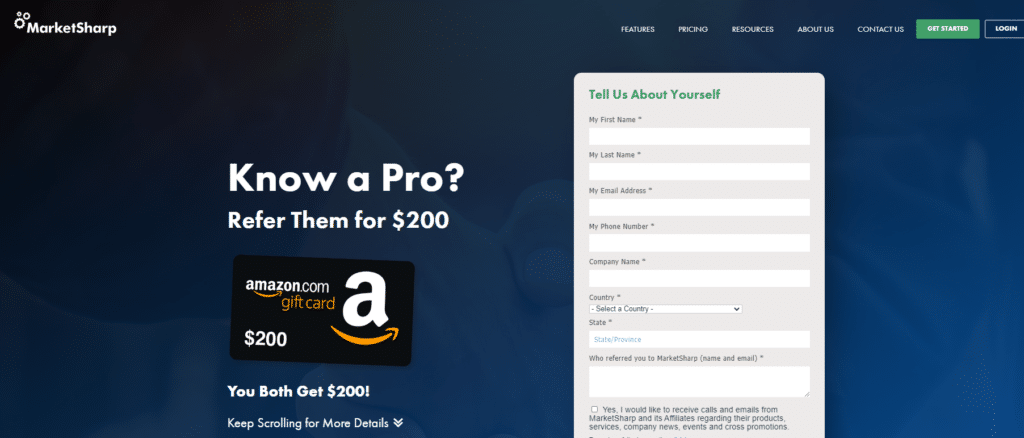
(Check out our Referral Page to see an example of how to set up a referral request page.)
6. Leverage Customer & Partner Referrals
One of the most meaningful compliments your flooring business can receive is a referral from a satisfied customer or partners. Don’t assume people will automatically provide referrals and online reviews. You need to have a plan in place to encourage them.
How to Get Referrals
Nurturing relationships with your contacts can help you unlock more opportunities and transform your referral process into a lead generation machine.
Requesting Referrals
Like you, your customers and partners are busy. Providing referrals or an online review is probably not top-of-mind for them. However, many people are very happy to do so when they are asked. The key to getting referrals is to make it easy for your customers and partners to make them.
Here are some ways to request referrals:
- Directly ask customers to write a Google review; send them an email or text with a link to your Google business listing
- Reach out via social media
- Request referrals in your email newsletter
- Ask to be added to a partner’s newsletter
- Write a thank-you note after job completion and request the favor of referrals
- Set up bi-annual partnership meetings where referrals are discussed
Incentives
Often, you can get more referrals if you sweeten the pot. Many folks will provide lead referrals in exchange for incentives such as:
- A discount on their next project
- Cash for each referral that becomes a paying customer
- Gift cards—these could be for a major retailer or one of your business partners
- Custom incentives—for example, tickets to a sporting or theater event or a VIP invite to a party you host
Need a system to help you request referrals? MarketSharp can help.
How to Manage Referrals
If you struggle to find time for managing referrals, consider delegating this task. An employee or virtual assistant can help you whether you manually track leads or use software to manage leads.
Thank customers who send referrals your way. Your appreciation can be as simple as a text or phone call. However, a handwritten note will be sure to stand out in a world where personalized snail mail is becoming rarer.
Also, be sure to show your appreciation to business partners who supply you with leads. Call them to thank them and give them a shout-out in your newsletter and social media. Tagging their businesses and providing links to their websites will really show your love.
Build a Holistic Strategy for Lead Generation and Referrals
Building a steady stream of leads is not a one-and-done task. It’s an on-going process that requires a holistic strategy that includes:
- Launching partnerships with other businesses
- Expanding your network
- Growing with digital marketing, including paid and organic SEO and social media
- Targeted mailings
- Improving customer experience so customers are eager to refer your flooring company
- Requesting and managing lead referrals
It sounds like a lot, doesn’t it? Fortunately, you don’t have to do everything for lead generation at once, and you don’t have to do it alone. Our proven MarketSharp software solutions are backed by over 30 years of helping flooring professionals like you grow their businesses.
Learn More About MarketSharp
Link Your Sales, Project Management & Lead Generation Processes with MarketSharp.
